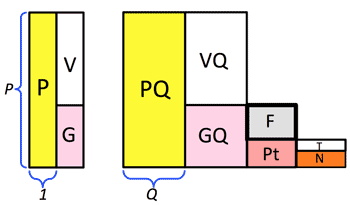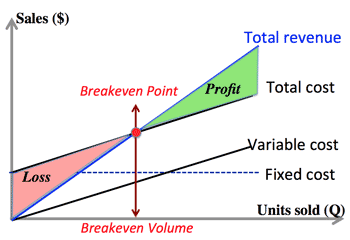>Top 5. Shrinking Profits in Accounting:
- Abbreviation:
ProfitperUnit (P), VariableCost (V), GrossProfit (G)
→ SalesQuantity (Q), FixedCost (F), PreTaxProfit (Pt), Tax (T), NetProfit (N)
- VariableCostRatio = V/P
- Breakeven Sales (BES): Pr=0; GQ=F
 - Ex: Finding the Breakeven Point (BEP):
- AA Corp. calculated that its Fixed costs (rease, depreciation, full-time presonel expenses, property taxes, etc.) added up $60,000.
- Their variable costs associated with manufacturing are raw material , factory labor, and sales commissions. Variable costs were $0.80 per unit.
- The Product is priced at $2.00 per unit.
- Thus: Breakeven Point (BEP) of AA Corp 's product:
60,0002.00−0.80=50,000 units [F=GQ]
- AA Corp. must sell 50,000 units to attain BEP.
- How Cutting Costs affect the BEP:
- If you cut the Fixed cost from 60,000to50,000. The above formula becomes: 50,0002.00−0.80=41,667 units
- If you reduce the Variable cost from 0.80to0.60 per unit, then:
60,0002.00−0.60=42,857 units
|
4.
会計における縮小する利益:
- ProfitperUnit (P): 単位当たり利益
- VariableCost (V): 単位当たり変動費
- GrossProfit (G): 単位当たり売上総利益
- SaleQuantity (Q): 販売数量
- FixedCost (F): 固定費
- PreTaxProfit (Pt): 税引前利益
- Tax (T): 租税公課
- NetProfit (N): 純利益
- 7つの利益:
- 売上総利益 (Gross Profit): 商品力;
売上−売上原価
- EBITDA (金利税償却前利益):
売上総利益−販売一般管理費(除、金利)
- 営業利益 (Oprerating Profit): 営業力;
売上総利益−販売一般管理費
- EBIT (金利外営業利益);
営業利益+営業外損失(除、金利)
- 経常利益 (Ordinary Profit); 財務力;
営業利益+営業外収益ー営業外費用
- 税引前当期純利益 (Pretax Profit); 臨時
経常利益+特別利益−特別損失
- 当期純利益 (Net Profit); 最終利益
税引前当期純利益−法人税等
|

